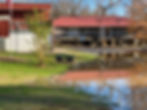
"The old families of Virginia will form connections with low people, and sink into the mass of overseers' sons and daughters".
- John Randolph of Roanoke














































Paul Carrington’s Mulberry Hill
Compiled by J. Shane Newcombe for the Historic Staunton River Foundation, all text and images herein are property of the author. Please contact the Foundation for dissemination and use.
Situated in the southern end of the county in Randolph near the Staunton River lies Mulberry Hill plantation, the historic ancestral home of Virginia’s prominent Carrington family. Within the last year, the descendants of Judge Paul Carrington donated the famed house and approximately forty acres of land to the Department of
Conservation and Recreation. It has now become a component of the Staunton River Battlefield State Park. The chronicles of Mulberry Hill run deep in the history of Charlotte County and Southside Virginia.
Paul Carrington was born at “Boston Hill” in Cumberland County on March 16, 1733 to George and Anne Mayo Carrington. His father, George, was the son of Dr. Paul Carrington and Henningham Codrington who migrated from England to the Island of Barbados. George immigrated to the Colony of Virginia in 1723, settled in Cumberland County and in 1732 married Anne Mayo. He was a wealthy planter, Clerk of Cumberland County, and an elected member to the House of Burgesses. Within a year, Paul, the eldest of eleven children, was born.
Very little is known of his early education other than the fact that he was educated under a private tutor and did not attend college. During 1750, Carrington moved to Lunenburg County and settled in what would become Charlotte County. He was employed by Colonel Clement Read in the clerk’s office and by 1755 was admitted to the Bar, and over the next several years served as the King’s attorney for the counties of Bedford, Mecklenburg, and Lunenburg. It is most interesting to note that John Randolph, Peyton Randolph, and George Wythe signed his license to practice law. Also in 1755, he married Margaret Read, the daughter of his employer, Colonel Clement Read. In 1765, Charlotte County was formed and Carrington was elected to the House of Burgesses, where he remained as a prominent member until 1776. While in the House of Burgesses, Carrington promoted resolutions supporting the independence of Virginia and later for the independence of a nation.
During the Revolution, he along with Thomas Read represented their home county of Charlotte at the fifth Revolutionary Convention that convened in 1776. It was at this Convention, that the delegates implemented a proposal that stated to “declare the United Colonies free and independent States , absolved from all allegiance to, or dependence upon, the crown or parliament of Great Britain”. This resolution was quickly adopted by the General Congress, and it is directly reflected in the Declaration of Independence that would be signed less than two months later.” Paul Carrington also played a vigorous role in the development of the Virginia Declaration of Rights, which assisted as a model for the Bill of Rights and the Constitution.
After Virginia established its own constitution as a so vereign state, Carrington was elected to the House of Delegates, and after two years was appointed as a bench member to the new judiciary, the Virginia General Court. He soon became the Chief Justice of the General Court in 1780. During the Virginia Convention of June 1788, it is recorded that Carrington voted for the narrow ratification of the Federal Constitution. Shortly, a second constitution for the Commonwealth was written, and in 1789, the Virginia Court of Appeals was created where Carrington was “appointed as one of the five justices”.
In 1807, he retired from public service by writing a letter of resignation to Governor William H. Cabell, which stated: “Having served my country for forty-two years, without intermission – twenty-nine of those years devoted to the judiciary department – and being now in the seventy-fifth year of my age, I think it time for me to retire from public business to the exalted station of a private citizen.” Judge Carrington returned to Mulberry Hill to live out his last years as a “private citizen”, Mulberry Hill had been his beloved home as a young man. It was on October 1, 755, that he married Margaret Read and settled to his Mulberry Hill plantation.
Over the next several years, their union bore five children, but tragedy struck on May 1, 1766, when Margaret died. She is buried at Mulberry Hill. He is remembered as honoring her by stating; “she was the best of wives and a woman of innumerable virtues.” Twenty-six years passed, and on March 6, 1792, he married Priscilla Sims, the daughter of David Sims and Lettice May of Halifax County. This marriage too was short lived as Priscilla died in 1803 at the early age of twenty-seven. Despite the brevity of their marriage, six children were born and two passed away in their infancy. She too was laid to rest on the grounds of the plantation.
A few years passed, and Carrington died on June 23, 1818. He had lived a successful life as a colonial planter, lawyer , and politician, who helped a colony gain its independence as well as help mold a new country. The Richmond Enquirer in its July 7, 1818 edition stated, “This venerable and highly respectable gentleman was perhaps the oldest of the few surviving Patriots who took an active part in the counsels of his country, in her first struggle for liberty and independence.” He was buried at his beloved Mulberry Hill between his two wives.
Mulberry Hill plantation continue s to stand as a memorial to its famous forbearer. Carrington’s descendants successively occupied the home until being officially added to the Staunton River Battlefield State Park in 2003. The estate produced “a number of family members that distinguished themselves as state legislators, business executives, lawyers, and Confederate officers.”
The history of the house and land began around 1755, when young Paul Carrington married Margaret Read, the daughter of Colonel Clement Read. It was from his father-in-law, that Carrington purchase d 687 acres of land on the upper side of the Little Roanoke River. It is presumed that the two-story frame house was built between 1756 and 1760. This estimate between 1756 and 1760 is assumed because on December 8, 1760 a separate deed claims Carrington was living on his own land at the time the document was recorded. This deed for an additional 12-½ acres states, “where said Carrington now lives....purchased of Clement Read.” The original dwelling of Carrington in all probability only incorporated the middle gable-end portion of what is now the current structure.
Around the 1830’s, John Blair McPhail, the occupant of the house with twelve children would have been the probable candidate of building onto the house the single-bay, two-story wings that flank the middle gable-end section for additional space. Some years later, the porch was converted with Doric columns and another addition was added but this time to the rear of the middle section, making the house into an almost uniform T-shape.
Carrington continued to acquire additional acreage for his plantation, and by about the beginning of the Revolution Mulberry Hill consisted of approximately 2,800 acres. The borders of the plantation extended from the Little Roanoke Creek down to the Staunton River as well as bordering much of the land of John Randolph. The estate derived the name “Mulberry Hill” from the endeavor to raise silk worms that feed on the overabundant mulberry trees located throughout the acres. The plantation in addition to acreage also contains a most unusual inclusive arrangement of outbuildings and dependencies that range from Judge Carrington’s law office, slave quarters, a dairy, a smokehouse, and a spinning house. These buildings add to the wealth and magnitude of the plantation due to the fact that they have not been altered or even moved to an
alternate location.
The house and grounds of Mulberry Hill played a very important role in the June 26, 1864 Battle of Staunton River Bridge. It was at Mulberry Hill where Brigadier General James H. Wilson and his invading Union forces occupied the house and grounds as a headquarters and field hospital. Despite the threat of war and having her home temporarily taken, Mrs. John B. McPhail stood bravely before the assaulting Union forces and untruthfully informed them that there were no less than ten thousand Confederate forces assembled to defend the bridge. In actuality, there were approximately 938 men (642 of them were the infamous “old men and young boys” and 296 reserve forces) under Captain Benjamin Farinholt’s command. These valiant men thwarted three advances to destroy the bridge by more than five thousand cavalry. By the end of the day, Staunton River Bridge, the focal point of the battle, had been spared; also as importantly, the occupying forces at Mulberry Hill withdrew and the house was saved.
Just as the grounds and outbuildings have enhanced the history of Southside Virginia, the interior of the home also has a most intriguing role for present and future generations. Inside the walls of Mulberry Hill lies another ty pe of wealth and magnitude. The interior is believed to contain a great deal of the original 18 thcentury carpentry and architectural features. There is also a plethora of knowledge and information found inside the more than 5,000 separate documents of the family’s papers that are safely archived at the Virginia Historical Society.
Fortunately, the descendants of Judge Paul Carrington saw the need to preserve the life of a “successful colonial politician, lawyer, and planter who became a prominent figure in Virginia politics” during our nation’ s birth for future generations. In May 2003, Mulberry Hill with forty acres of land was donated to the State Park; however, much work is needed to faithfully safeguard the house and grounds. Over the next several years, the house will undergo an extensive stabilization, renovation, and restoration effort. During this time, the house will be closed to the public, but hopes are to reopen the house as an interpretive educational tool.
With the acquisition of Mulberry Hill in to the Staunton River Battlefield State Park, the legacy and accounts of the many occupants of Mulberry Hill plantation from the illustrious patriot Judge Paul Carrington to the heroic Mrs. John B. McPhail will be retold countless times to preserve the important history of Southside Virginia.



